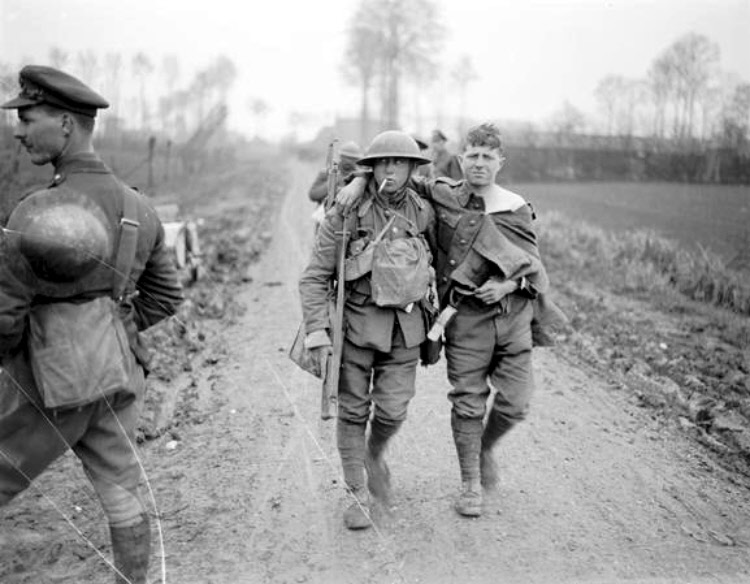
Irving Hill was born in 1899 in Dewsbury, the son of John Edward Hill and Charlotte (nee Lord) who married in 1895 in Dewsbury. They had four children, but only Irving and his elder sister, Miriam, born 1897, survived to their teenage years. In 1901 and 1911, the family were living in Dewsbury, where John Edward worked as a woollen pattern warper. Sometime after 1915, the Hill family moved to 50, Dewsbury Road, Street Side, Ossett.
The 15th (Service) Battalion (1st Leeds) was formed in Leeds in September 1914 by the Lord Mayor and City. In June 1915, the Battalion came under orders of 93rd Brigade, 31st Division and in December 1915 they moved to Egypt. The Battalion went on to France in March 1916 and on the 7th December 1917 they amalgamated with 17th Battalion to form 15th/17th Battalion.
The 17th (Service) Battalion (2nd Leeds) was formed in Leeds in December 1914 by the Lord Mayor and City, as a bantam Battalion for men whose height was below the regulation 5′ 3″. In June 1915 the battalion came under orders of 106th Brigade, 35th Division and on the 1st February 1916 they landed at Le Havre. On the 16th November 1917 they left 35 Division for XIX Corps engaged on railway work and amalgamated with 15th Battalion in December 1917 to form the 15th/17th Battalion.
Private Irving Hill died on the opening day of the Battle of Hazebrouck on the 12th April 1918, when his Division was at the very epicentre of the German attack. The Allied strategy for the 12th was to contain the Germans primarily by using existing troops already committed to the battle. The decision was to “patch and mend” the line using the bare minimum of resources necessary, whilst buying time for the construction of a new line of defence about a mile to the rear by fresh troops being moved up of the 1st Australian Division.
“The German strategy during the morning of the 12th was to focus the main effort on the drive to Hazebrouck. At noon, General Ludendorff issued orders to re-focus the maximum effort away from Hazebrouck eastwards against Bailleul and beyond. The new objective was the line of the Flanders hills, which ran in a north easterly direction behind Bailleul towards Messines and onwards to Ypres.
The outcome of the day was that the Germans punched two large salients into the Allied lines; two bulges on either side of the village of Vierhouck in front of Hazebrouck. The northern salient was approximately 3 miles deep by 5 miles wide, and the southern salient approximately 2 miles deep by 7 miles wide. The Germans failed in their objectives of reaching either Hazebrouck or Baillieul. Conversely, the allies succeed in their objective by holding the line, whilst work continued on creating the new defensive line to the rear.
At 7 am on the 12th April; the main German attack centred on the join of 29th & 31st Divisions. Six German Divisions launch an attack aimed at the front line positions in the centre of the battlefield being held by the reduced units of the 29th, 31st and 34th Divisions. The Official History records “their principal effort being made by a fresh division, the 81st Reserve, against the 86th Brigade (of the 29thDivision)”. 8 am to noon. The Germans advance up the line of the Meteren Becque; splitting the 86th and 92nd Brigades.
Near Ferme Du Bois, they also succeed on splitting the 92nd and 93rd Brigades, inflicting serious losses through enfilade fire. Noon to 6:30 pm. The line becomes untenable, and the mass retirement of the 29th, 31st and 34th Divisions begins. By 6:30 pm these Divisions are all holding the “end of day” line in front of Vieux Berquin, Merris & Bailleul.” 1

Above: British wounded at the Battle of Hazebrouck in April 1918.
Irving Hill’s army service record has not survived. He did not serve overseas before 31 December 1915, but was awarded the British and Victory medals.
Private Irving Hill died on the 12th April 1918, aged 19 years, and is buried at grave reference II. B. 17. at the Le Grand Beaumart British Cemetery, Steenwerck 2, Nord, France. Steenwerck is a village in the Department of the Nord, on the south-west side of the Armentieres to Bailleul road (D933).
Steenwerck remained untouched for much of the First World War, but on 10 April 1918 it was captured during the German advance and remained in their hands until the beginning of October.
The original cemetery (now Plot I, Rows A to D) was made by fighting units and field ambulances in April and October 1918, and contained 55 graves. It was increased after the Armistice when graves were brought in from the battlefields of Steenwerck, Nieppe and Armentieres. Among them were 116 Commonwealth graves from Steenwerck German Cemetery, a large burial ground on the Steenwerck-Trois Arbres road.
Le Grand Beaumart British Cemetery contains 553 burials and commemorations of the First World War. 108 of the burials are unidentified but there are special memorials to 12 casualties known to be buried among them, and to three soldiers buried in the cemetery in April 1918 whose graves were destroyed by shell fire. Eight other special memorials commemorate casualties known to have been buried in Steenwerck German Cemetery whose graves could not be found.
References: